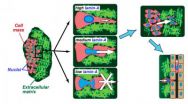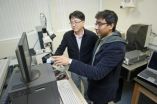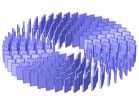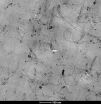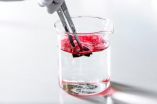(Press-News.org) Adult stem cells and cancer cells have many things in common, including an ability to migrate through tiny gaps in tissue. Both types of cells also experience a trade-off when it comes to this ability; having a flexible nucleus makes migration easier but is worse at protecting the nucleus' DNA compared to a stiffer nucleus. Nuclear proteins that regulate nuclear stiffness are therefore thought to control processes as diverse as tissue repair and tumor growth.
In a study published in the Journal of Cell Biology, researchers at the University of Pennsylvania have shown that cell migration through micron-size pores is regulated by lamin-A, a nuclear protein that is very similar to the fibrous ones that make up hair.
They have also shown that a cell's ability to survive the mechanical stress of migration depends on proteins called "heat shock factors." Using an anti-cancer drug that inhibits heat shock responses, they showed that this drug's effectiveness relies on inhibiting the invasive migration of cells via the same mechanism.
Taking into account the role that lamin-A plays in increasing nuclear stiffness could help stem cell biologists and cancer clinicians interpret the diversity of nuclear shapes seen in a static sample of tissue under a microscope. Nuclei normally appear rounded but can also appear multi-lobed or greatly elongated; high lamin-A levels tend to produce the more distorted shapes after a cell squeezes its nucleus through a narrow pore.
"If we can understand more clearly the effects the lamin-A meshwork within nuclei has on the ability of cells to crawl through tiny openings," said Dennis Discher, professor in the Department of Chemical and Biomolecular Engineering in the School of Engineering and Applied Science, " then we can develop better nucleus-directed treatments for stopping the spread of cancer or for keeping stem cells in the right place while they grow into tissue."
Discher, along with lead author Takamasa Harada, a graduate student in his lab, conducted the studies with fellow lab members Joe Swift, Jerome Irianto, Jae-Won Shin, Kyle Spinler, Avathamsa Athirasala, Dave Dingal and Irena Ivanovska, as well as undergraduate student Rocky Diegmiller.
The study's experiments were conducted on immortalized human cancer cells as well as human-donor-derived mesenchymal stem cells, which are in wide use in clinical trials for tissue repair. The researchers either inhibited or overexpressed lamin-A in the cells, then placed both kinds on top of a thin sheet with very small pores. By adding blood serum to a chamber on the bottom of the porous sheet, the researchers encouraged the cells to push, pull and squeeze their nuclei through the pores.
Looking under a microscope at the cells that made it though the sheet revealed very few of the cells where lamin-A had been overexpressed. There was also a dearth of cells where lamin-A was strongly repressed. The cells that were most successful in migrating through the sheet's pores were the ones with lamin-A only slightly less than normal.
"The decreased migration with very low lamin-A levels was especially surprising," Harada said, "and so we measured the physical stiffness of the various nuclei, confirming that cell nuclei were systematically softer with low levels of lamin-A."
"While cells with stiffer nuclei are clearly unable to push or pull their nuclei through the pores," he said, "all of the softer nuclei could be moved through more easily, which presented a paradox."
To resolve the paradoxical decrease in cell number with very soft nuclei, the researchers saw that the cells on the bottom of the porous sheet turned on a marker for cell death that was otherwise absent from cells on top and the lower the lamin-A the greater the number of dying cells. As a cell squeezes its nucleus through a small pore, cell death is triggered and more so when lamin-A is low.
"Moderate decreases in lamin-A allow more cells to migrate and live," Discher said, "but, when lamin-A is too low, death dominates migration. The narrow pore becomes a torture chamber for the DNA. We were bewildered by this and analyzed hundreds of proteins for some clue, discovering that another stress response pathway is deficient when lamin-A is very low. The heat shock proteins are famous for being turned on by high temperature stress to protect DNA and the rest of the cell, and the underlying gene circuitry somehow turns off when lamin-A is made artificially low."
The researchers showed that treating cells that have normal levels of lamin-A with a drug that inhibits heat shock proteins had the same effect as reducing lamin-A levels. The findings provide a better fundamental understanding of the roles of nuclear stiffness and stress resistance and could underpin other treatments as well.
"There really were no previous studies showing that the nucleus in stem cells and cancer cells could have such a prominent role in cell trafficking," Discher said. "And, since we confirmed some of our cell culture observations by studying human tumor growth in mice, this very physical mechanism must apply to human tissue as well. Nuclear stiffness is a property that should also help keep stem cells anchored in their niche until tissue is damaged to release the cells."
INFORMATION:
The research was supported by the National Institutes of Health and the National Science Foundation.
Penn researchers show nuclear stiffness keeps stem cells and cancer cells in place
2014-02-25
ELSE PRESS RELEASES FROM THIS DATE:
Climate engineering: Minor potential, major side effects
2014-02-25
Despite international agreements on climate protection and political declarations of intent, global greenhouse gas emissions have not decreased. On the contrary, they continue to increase. With a growing world population and significant industrialization in emerging markets such as India and China the emission trend reversal necessary to limit global warming seems to be unlikely. Therefore, large-scale methods to artificially slow down global warming are increasingly being discussed. They include proposals to fertilize the oceans, so that stimulated plankton can remove ...
Breast-feeding benefits appear to be overstated, according to study of siblings
2014-02-25
COLUMBUS, Ohio – A new study comparing siblings who were fed differently during infancy suggests that breast-feeding might be no more beneficial than bottle-feeding for 10 of 11 long-term health and well-being outcomes in children age 4 to 14.
The outlier was asthma, which was associated more with breast-feeding than with bottle-feeding.
The study also included an analysis of outcomes across families of different races and socioeconomic circumstances for comparison purposes, and those results matched other studies suggesting that breast-feeding's benefits to children ...
Smartphone-based voting technology may lead to fewer user errors
2014-02-25
Many U.S. counties have incorporated electronic voting technology, largely in response to well-publicized challenges related to older mechanical and punch-card models. Although these updated systems have solved some usability problems, they present a new set of issues for voters unfamiliar with the technology. A new study published in Human Factors examines how smartphone-based voting systems can be incorporated into the current large-scale election process.
"Current electronic voting systems have numerous issues - from usability and accessibility to security to the ...
New approach to chip design could yield light speed computing
2014-02-25
Every second, your computer must process billions of computational steps to produce even the simplest outputs. Imagine if every one of those steps could be made just a tiny bit more efficient. "It would save precious nanoseconds," explained Northeastern University assistant professor of physics Swastik Kar.
Kar and his colleague Yung Joon Jung, an associate professor in the Department of Mechanical and Industrial Engineering, have developed a series of novel devices that do just that. Their work was published recently in the journal Nature Photonics.
Last year, the ...
Geology covers Mars, the Moon, anthropogenic lead poisoning, earthquake hazards, and more
2014-02-25
Boulder, Colo., USA – The Geological Society of America's top journal, Geology, displays its multidisciplinary best in this latest posting. Earth science disciplines covered include geoarchaeology, climatology, invertebrate paleontology, sedimentology, geomorphology, seismology, planetary geology, geochemistry, glaciology, plate tectonics, mineralogy, and environmental and medical geology. Locations include Mars; Earth's moon; India; the Tibetan Plateau; the Saskatchewan River; L'Aquila, Italy; the Antarctic; Australia; the Andes; the San Andreas fault system; and Kume ...
Scientists twist sound with metamaterials
2014-02-25
WASHINGTON D.C. Feb. 25, 2014 -- A Chinese-U.S. research team is exploring the use of metamaterials -- artificial materials engineered to have exotic properties not found in nature -- to create devices that manipulate sound in versatile and unprecedented ways.
In the journal Applied Physics Letters, the team reports a simple design for a device, called an acoustic field rotator, which can twist wavefronts inside it so that they appear to be propagating from another direction.
"Numerous research efforts have centered on metamaterial-based devices with fascinating wave-control ...
Improvement in polymers for aviation
2014-02-25
We live surrounded by polymers and today, rather than come up with new polymers, there is a tendency to modify them in order to obtain new applications. Carbon nanotubes have excellent mechanical properties, are very tough, very rigid, and what is more, they conduct electricity. "The problem with them is that they get dispersed, in other words, it's very difficult to get them to blend with polymers," explained Iñaki Eguiazabal, a member of the Polymer Technology Group. That is why it is essential to come up with methods that will enablethe carbon nanotubes to have a ...
'Greener' aerogel technology holds potential for oil and chemical clean-up
2014-02-25
MADISON, Wis. – Cleaning up oil spills and metal contaminates in a low-impact, sustainable and inexpensive manner remains a challenge for companies and governments globally.
But a group of researchers at the University of Wisconsin–Madison is examining alternative materials that can be modified to absorb oil and chemicals without absorbing water. If further developed, the technology may offer a cheaper and "greener" method to absorb oil and heavy metals from water and other surfaces.
Shaoqin "Sarah" Gong, a researcher at the Wisconsin Institute for Discovery (WID) ...
Glycerol phenylbutyrate reduces hepatic encephalopathy events
2014-02-25
Phase 2 trial results published in the March issue of Hepatology, a journal of the American Association for the Study of Liver Diseases, suggests the potential for Glycerol Phenylbutyrate (GPB) to reduce hepatic encephalopathy episodes in patients with cirrhosis, with a safety profile similar to placebo.
Patients with hepatic encephalopathy experience neuropsychiatric symptoms that may range from mild confusion to coma. There is conflicting evidence on the link between elevated blood ammonia and hepatic encephalopathy. Poorly-absorbable disaccharides and antibiotics ...
Sensor-based irrigation systems show potential to increase greenhouse profitability
2014-02-25
COLLEGE PARK, MD--Wireless sensor-based irrigation systems can offer significant benefits to greenhouse operators. Advances in sensor technology and increased understanding of plant physiology have made it possible for greenhouse growers to use water content sensors to accurately determine irrigation timing and application rates in soilless substrates. The wireless sensor systems provide more accurate measurements of substrate moisture than qualitative methods, and can save irrigation water, labor, energy, and fertilizer. The authors of a report published in HortTechnology ...
